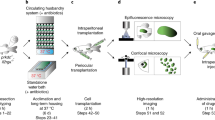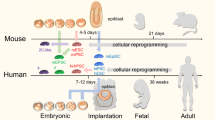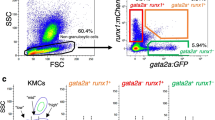Abstract
Cell transplantation into adult zebrafish has lagged behind mouse models owing to the lack of immunocompromised strains. Here we have created rag2E450fs mutant zebrafish that have reduced numbers of functional T and B cells but are viable and fecund. Mutant fish engraft muscle, blood stem cells and various cancers. rag2E450fs mutant zebrafish are the first immunocompromised zebrafish model that permits robust, long-term engraftment of multiple tissues and cancer.
This is a preview of subscription content, access via your institution
Access options
Subscribe to this journal
Receive 12 print issues and online access
$259.00 per year
only $21.58 per issue
Buy this article
- Purchase on Springer Link
- Instant access to full article PDF
Prices may be subject to local taxes which are calculated during checkout



Similar content being viewed by others
References
Traver, D. et al. Nat. Immunol. 4, 1238–1246 (2003).
Traver, D. et al. Blood 104, 1298–1305 (2004).
White, R.M. et al. Cell Stem Cell 2, 183–189 (2008).
Blackburn, J.S. et al. Leukemia 26, 2069–2078 (2012).
Ignatius, M.S. et al. Cancer Cell 21, 680–693 (2012).
Smith, A.C. et al. Blood 115, 3296–3303 (2010).
Moore, F.E. & Langenau, D.M. Adv. Hematol. 2012, 478164 (2012).
Sander, J.D. et al. Nat. Methods 8, 67–69 (2011).
Couëdel, C. et al. J. Clin. Invest. 120, 1337–1344 (2010).
Villa, A. et al. Blood 97, 81–88 (2001).
Ramón-Maiques, S. et al. Proc. Natl. Acad. Sci. USA 104, 18993–18998 (2007).
Mombaerts, P. et al. Cell 68, 869–877 (1992).
Wienholds, E., Schulte-Merker, S., Walderich, B. & Plasterk, R.H. Science 297, 99–102 (2002).
Mosimann, C. et al. Development 138, 169–177 (2011).
Higashijima, S., Okamoto, H., Ueno, N., Hotta, Y. & Eguchi, G. Dev. Biol. 192, 289–299 (1997).
Langenau, D.M. et al. Oncogene 27, 4242–4248 (2008).
Langenau, D.M. et al. Science 299, 887–890 (2003).
Langenau, D.M. et al. Genes Dev. 21, 1382–1395 (2007).
Patton, E.E. et al. Curr. Biol. 15, 249–254 (2005).
Ceol, C.J. et al. Nature 471, 513–517 (2011).
Meeker, N.D., Hutchinson, S.A., Ho, L. & Trede, N.S. Biotechniques 43, 610–614 (2007).
Langenau, D.M. et al. Proc. Natl. Acad. Sci. USA 102, 6068–6073 (2005).
Blackburn, J.S. et al. Cancer Cell 25, 366–378 (2014).
Le, X. et al. Proc. Natl. Acad. Sci. USA 104, 9410–9415 (2007).
Acknowledgements
This work is supported by the Alex's Lemonade Stand Foundation (J.S.B., M.S.I., D.M.L.), the Leukemia & Lymphoma Society (J.S.B.), the American Cancer Society (D.M.L.), a Massachusetts General Hospital Howard Goodman Fellowship (D.M.L.) and US National Institutes of Health grants F32DK098875 (F.E.M.), R24OD016761 and 1R01CA154923 (D.M.L.). Q.T. is funded by the China Scholarship Council. J.N.B. is funded as the Cancer Care Nova Scotia Peggy Davison Clinician. We thank D. Traver, T. North and J. Rawls for their helpful comments and B. Li for advice.
Author information
Authors and Affiliations
Contributions
Q.T., N.S.A., J.S.B., J.C.M., S.A.M., I.M.T. and D.M.L. designed and performed experiments. Q.T., J.C.M. and D.M.L. wrote the manuscript. F.E.M., R.L., I.M.T., M.S.I. and Y.H. contributed reagents and animals. Q.T., N.S.A., J.C.M., J.N.B., R.S.L. and D.M.L. performed data analysis and interpretation.
Corresponding author
Ethics declarations
Competing interests
The authors declare no competing financial interests.
Integrated supplementary information
Supplementary Figure 1 Homozygous rag2E450fs mutants are healthy and viable similar to wild-type and heterozygous siblings.
(left) Representative bright-field images of wild type (wt), heterozygous (het) and homozygous mutant (mut) animals derived from a rag2E450fs heterozygous mating. (right) Quantification of animal length at 2.5 months of age with number of genotyped animals per clutch annotated. Error bars show ±1 s.d. Scale bars denote 2.5 mm.
Supplementary Figure 2 Homozygous rag2E450fs mutants have reduced T-cell numbers and thymus size at 5 d of life.
(a-b) Whole mount in situ hybridization for rag1 in 5-day-old zebrafish, arrows denote thymus. (c) 2-dimensional pixel counts to quantify thymus size based on rag1 staining. Error bars denote ±1 standard deviation and asterisk denotes a significance of p=0.002, Student’s t-test.
Supplementary Figure 3 Percentage of ubi-EGFP+ blood cell engraftment in recipient fish at 45 d post transplantation.
The percentage of EGFP+ cells assessed by FACS of whole kidney marrow isolated from AB-strain wild type fish (Control) or transplanted wild type and homozygous rag2E450fs mutant zebrafish.
Supplementary Figure 4 Manual dissection and cell harvesting protocols produce viable muscle cells.
FACS analysis of whole blood isolated from AB-strain wild type fish (negative control) and stained with propidium iodide (PI), compared to manually dissected muscle obtained from 12-month-old mylpfa-EGFP transgenic animals.
Supplementary Figure 5 Homozygous rag2E450fs mutant zebrafish engraft EGFP+ muscle from ubi-EGFP transgenic donor animals.
(a) Low magnification images of rag2E450fs mutant zebrafish engrafted with ubi-EGFP donor muscle cells. Myotome segments (arrows), anti-GFP immunostaining (αGFP) and hematoxylin and eosin (H&E). (b) Higher magnification views of boxed region. Activated caspase 3 antibody (αCaspase3) and TUNEL staining on adjacent sections. (c) Thymus sections. Low magnification (left panel) and high magnification views of boxed region (right three panels). Hematoxylin and eosin stained sections (left two panels). Right two panels show a large number of thymic T cells undergo apoptosis during T cell maturation and providing a good control for verifying apoptotic cell staining on section. Scale bars denote 500 µm (a), 100 µm (b, c-left), 50 µm (c-three right panels).
Supplementary Figure 6 Genotyping strategy to identify rag2E450fs mutants.
(a) Genomic organization of the zebrafish rag2 gene with the core domain and Plant Homeodomain (PHD) denoted. Nucleotide sequences of wild type and mutant rag2E450fs alleles that span the ZFN target site (yellow), nucleotide additions blue and deletions gray. Boxed nucleotides denote de novo creation of an XcmI site within the rag2E450fs allele. Following PCR from fin clip isolated genomic DNA, amplified fragments are digested with XcmI and resolved on a 2% agarose gel containing ethidium bromide (b). Representative gel image with wild type (wt), heterozygous (het), and homozygous mutant (mut) animal results noted.
Supplementary information
Supplementary Text and Figures
Supplementary Figures 1–6 and Supplementary Tables 1–6 (PDF 2410 kb)
Circulating GFP+ blood cells in engrafted homozygous rag2E450fs zebrafish.
Homozygous rag2E450fs mutant zebrafish engrafted with marrow from ubi-EGFP transgenic donors showing circulation of GFP+ blood cells in the tail at 30 d post-transplantation. (MOV 17271 kb)
Rights and permissions
About this article
Cite this article
Tang, Q., Abdelfattah, N., Blackburn, J. et al. Optimized cell transplantation using adult rag2 mutant zebrafish. Nat Methods 11, 821–824 (2014). https://doi.org/10.1038/nmeth.3031
Received:
Accepted:
Published:
Issue Date:
DOI: https://doi.org/10.1038/nmeth.3031
This article is cited by
-
IRF4 drives clonal evolution and lineage choice in a zebrafish model of T-cell lymphoma
Nature Communications (2022)
-
In Vivo Modeling of Human Breast Cancer Using Cell Line and Patient-Derived Xenografts
Journal of Mammary Gland Biology and Neoplasia (2022)
-
The Zebrafish model in dermatology: an update for clinicians
Discover Oncology (2022)
-
The use of zebrafish model in prostate cancer therapeutic development and discovery
Cancer Chemotherapy and Pharmacology (2021)



